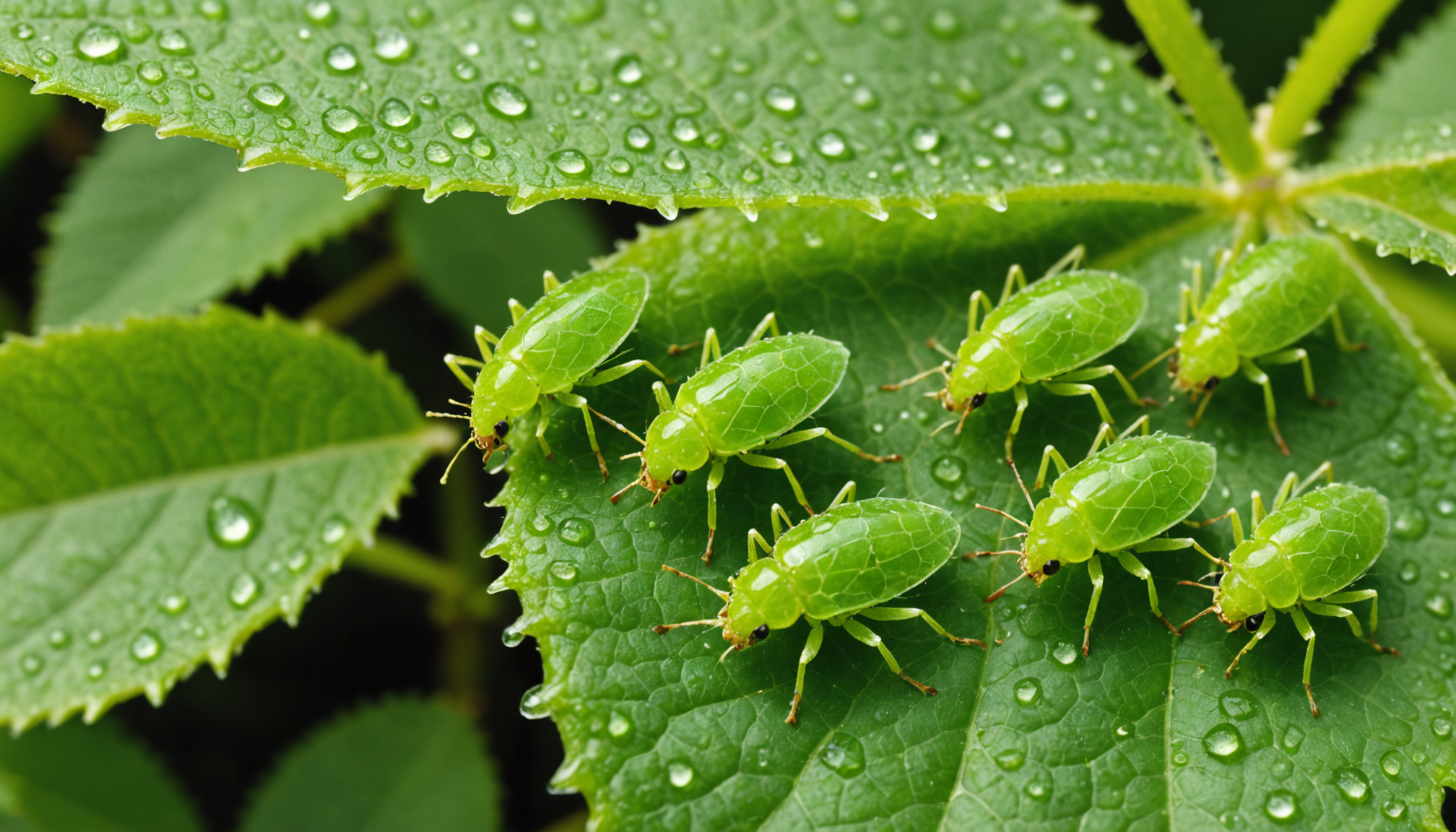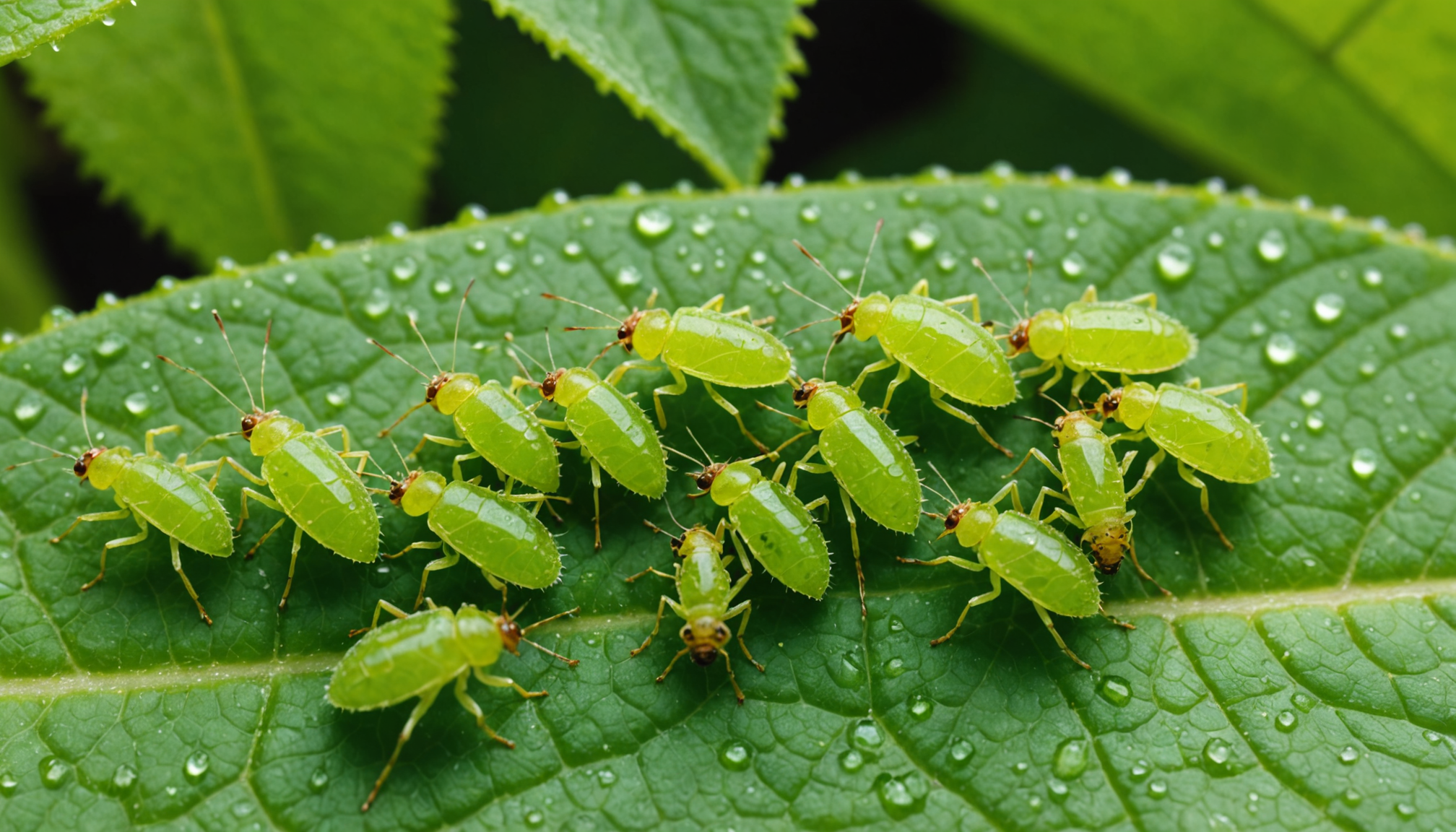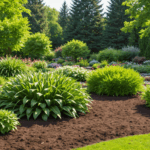Aphids are among the most notorious garden pests, minute in size yet capable of causing significant damage to a wide range of plants. These small, soft-bodied insects can be green, black, brown, red, or even white, adapting well to their environment and often going unnoticed until infestations have taken hold. They feed by sucking sap from plant tissues, particularly targeting the tender parts of new growth, leading to stunted growth, leaf curl, yellowing, and, in severe cases, plant death.
To effectively manage aphids, the first step is accurate identification. Key indicators include the presence of a sticky substance called honeydew on leaves and stems, which aphids excrete as they feed. This honeydew can promote the growth of sooty mold, an unsightly fungus that further damages plant health. Additionally, aphid infestations often attract ants, which are drawn to the honeydew and can, in turn, disrupt other biological pest control measures.
Once identified, there are several effective techniques to remove aphids and mitigate their impact on your garden:
- Manual Removal: For smaller infestations, manually removing aphids can be beneficial. Simply use your fingers or a gentle spray of water to dislodge the insects from leaves and stems, ensuring repeated treatment to target all life stages.
- Natural Predators: Encouraging beneficial insects such as ladybugs, lacewings, and parasitic wasps can provide natural aphid control. These predators consume large quantities of aphids, keeping their numbers in check without harming your plants.
- Neem Oil and Insecticidal Soap: Sprays containing neem oil or insecticidal soap act as effective pest control solutions. Applying these substances directly onto affected plants disrupts aphid growth and development, and their minimal impact on beneficial insects makes them an excellent choice for integrated pest management.
- Homemade Sprays: A solution of water mixed with a few drops of dish soap can also be sprayed onto plants to suffocate and kill aphids. Ensure that all plant surfaces are thoroughly coated for maximum effectiveness.
- Cultural Controls: Encourage plant health by maintaining optimal growing conditions. Healthy, robust plants are less susceptible to aphid damage and can often withstand low to moderate infestations.
Effectively managing aphid populations requires regular monitoring and integrated pest management practices. Understanding the life cycle and behavior of aphids is crucial for timely interventions. In the context of broader plant care, prioritizing preventive measures and enhancing the natural ecosystem balance within your garden will provide long-term solutions.
| Technique | Pros | Cons |
| Manual Removal | Immediate effect, inexpensive | Labor-intensive, less effective for large infestations |
| Natural Predators | Eco-friendly, targets only pests | Dependent on specific conditions or availability |
| Neem Oil/Insecticidal Soap | Effective, minimal side effects | May require multiple applications |
| Homemade Sprays | Cost-effective, easy to make | May not be as effective as commercial products |
By exploring these varied techniques, gardeners can tailor their pest control efforts to their specific environments, ensuring healthier and more resilient gardens. These methods are part of an overarching strategy to manage and minimize the impact of these common garden pests effectively, fostering a thriving garden ecosystem.
Controlling caterpillar infestations in your garden
When it comes to keeping your garden free from the damage caused by caterpillars, there are several effective strategies to consider. These measures focus on prevention, early detection, and targeted interventions.
1. Early Detection and Identification:
– Regular Inspection: Regularly inspect your plants, especially in the morning, for signs of caterpillar activity, such as chewed leaves, frass (caterpillar droppings), and eggs on the undersides of leaves.
– Identify Hatching: Knowing what species of caterpillars you’re dealing with can help tailor your control efforts. For instance, understanding the difference between a harmless butterfly larva and a destructive moth caterpillar is crucial for appropriate interventions.
2. Physical Removal:
– Handpicking: If only a few caterpillars are present, you can remove them manually. Simply wear gloves and pick them off by hand, placing them in a bucket of soapy water to prevent their return.
– Barrier Methods: Using floating row covers can physically prevent caterpillars from reaching your plants, while still allowing sunlight and water to penetrate.
3. Biological Controls:
– Encourage Predators: Birds, parasitic wasps, and other natural predators can significantly reduce caterpillar populations. By maintaining a bird-friendly garden with feeders and nesting areas, birds will help manage caterpillar numbers.
– Bacillus thuringiensis (Bt): This naturally occurring bacterium is a popular biological control method. It targets caterpillars without affecting beneficial insects or humans. Apply it when caterpillars are small, and reapply after rain.
4. Chemical Controls:
– Neem Oil: Neem oil disrupts the life cycle of caterpillars and acts as a repellent. Apply it in the evening to avoid harming beneficial insects like bees.
– Insecticidal Soaps: These are effective against caterpillars on contact. Make sure to thoroughly cover infested leaves and stems while applying.
5. Cultural Practices:
– Diversity Planting: Interplanting with species that deter caterpillars can act as a natural defense. Herbs like dill, lavender, and mint are less attractive and can serve as deterrents.
– Healthy Plant Care: Strengthen plant defenses through adequate watering, regular pruning, and proper fertilization. Healthy plants are better suited to withstand pest pressure.
6. Integrated Pest Management (IPM) Approach:
– Monitor and Adjust: Continuously monitor caterpillar populations and adjust your control measures as necessary, combining techniques as needed to maintain an effective balance.
By adopting these strategies for controlling caterpillar infestations, you not only protect your garden from damage but also promote a balanced ecosystem. This holistic approach to plant care and pest control ensures your garden remains both vibrant and resilient.
Slug prevention and mitigation strategies
While slugs might seem harmless at first glance due to their slow and slimy nature, they can become one of the most challenging garden pests to manage. These nocturnal creatures thrive in damp, shaded environments and are particularly fond of young seedlings and leafy vegetables, causing significant damage by devouring entire plants overnight. Fortunately, there are numerous strategies to prevent slugs from wreaking havoc in your garden.
Environmental Modifications: Creating an unfavorable environment for slugs can greatly reduce their presence. Start by reducing moisture levels in the garden, as slugs prefer wet conditions. Water plants in the morning, allowing the soil to dry by evening. Pruning excess foliage and clearing garden debris can also deprive slugs of their preferred hiding spots.
Physical Barriers: Implementing physical barriers can be an effective pest control measure. Surrounding your plants with copper tape or wire can deter slugs, as they experience an unpleasant reaction when they come into contact with copper. Alternatively, sprinkle crushed eggshells or diatomaceous earth around the base of plants. These abrasive materials are uncomfortable for slugs to traverse, effectively deterring them from reaching your plants.
Natural Predators: Encourage a natural ecosystem balance by attracting slug predators such as birds, toads, and ground beetles. Providing habitats like birdhouses and undisturbed areas for toads can encourage these predators to frequent your garden. They will help manage slug populations without the need for chemical interventions.
Trapping Techniques: Handpicking and trapping slugs can significantly reduce their numbers. Set up traps by burying containers at ground level and filling them with beer or a yeast-water mixture. Slugs are attracted to the fermenting smell and, upon entering the container, are trapped and later removed. Check traps regularly and replenish as needed to maintain efficacy.
Organic Control Options: Consider using iron phosphate-based slug pellets, which are safe for pets and wildlife. Unlike traditional chemical options, these pellets cause slugs to cease feeding and eventually perish without harming other garden organisms. Mulching with oak leaves or pine needles, known for their acidic properties, can also serve as a natural deterrent for slugs.
Cultural Practices in Plant Care: Maintain robust garden health to help plants withstand minor slug damage. Rotate crops annually to discourage slugs from establishing themselves in any one garden area. Cultivating companion plants such as mint, fennel, or rosemary can repel slugs due to their strong scent.
By integrating these slug prevention and mitigation strategies, gardeners can effectively protect their plants while fostering a healthier garden environment. These techniques align with broader plant care practices and highlight the importance of sustainable pest control methods, ensuring the vitality of your garden ecosystem without relying heavily on synthetic chemicals.
Dealing with garden snails naturally
When tackling the persistent problem of garden snails, natural and eco-friendly methods are both effective and sustainable. Snails, much like their close relatives the slugs, prefer damp conditions and can wreak havoc on your garden by chewing through leaves and stems, potentially destroying young or tender plants overnight. However, by utilizing a few strategic approaches, you can manage these garden pests effectively.
One straightforward method is to discourage snails from entering your garden by creating a habitat that is less appealing to them. Ensure your garden is well-drained by watering plants in the morning rather than evening, allowing the soil to dry out before nightfall, which is when snails are most active. Reducing unnecessary foliage and garden debris will eliminate the moist, shady hiding places snails favor.
For those looking to employ safe and humane pest control techniques, consider using natural barriers. Copper tape or mesh is an excellent deterrent, as the metal reacts unpleasantly with the snails’ slime, preventing them from crossing. Another option is to create barriers using rough-textured materials such as crushed eggshells, coffee grounds, or sand, which are uncomfortable for snails to crawl over. While these need to be replenished after rain, they provide a biodegradable alternative to pesticides.
As with slugs, attracting natural predators to your garden can help keep snail populations in check. Animals like birds, frogs, and small mammals are natural enemies of snails. Encourage these creatures by creating inviting habitats, such as placing a birdbath or leaving a corner of your garden undisturbed for frogs to hide in. Over time, these predators can significantly reduce snail numbers without the need for synthetic interventions.
If snails have already taken up residence, handpicking them during dawn or dusk is effective. Place them into a bucket of soapy water to humanely remove them from the garden. For those willing to put in a bit more effort, homemade traps can also be an effective solution. Bury containers at ground level and fill them with beer or a sugar-water mixture. Snails, lured by the scent, will crawl in and be unable to escape.
For gardeners looking for organic solutions, ferric phosphate-based snail baits offer a safe option. Unlike chemical baits, this compound is non-toxic to other wildlife, pets, and humans, yet effectively controls snail populations. Moreover, mulching with coffee grounds or pine needles, known for their mildly acidic properties, can ads as a repellent and enrich your soil concurrently.
Lastly, maintaining your garden’s health and diversity is crucial in integrated pest management. By rotating crops each season and incorporating a variety of companion plants like garlic or rosemary, which emit odors that snails find unappealing, you bolster your plants’ defenses against these pests. Ensuring robust plant care by providing adequate nutrition and pruning regularly also enhances your plants’ resilience to pest pressures.
By implementing these natural snail management techniques, you can safeguard your garden while promoting a balanced ecosystem. These methods emphasize sustainable plant care, leading to a healthier garden environment without reliance on chemical substances.
Managing spider mites on plants
Spider mites, though tiny, can cause significant damage to garden plants. These pests thrive in hot, dry conditions and tend to target a variety of plants, including ornamentals, fruits, and vegetables. Recognizing their presence is key; symptoms include yellowing or bronzing of leaves, which may eventually lead to leaf drop. A fine, web-like silk on the undersides of leaves is a tell-tale sign of a spider mite infestation.
To manage these pests effectively, it’s important to employ both preventive and immediate control measures. Regularly monitoring your plants is the first step. Check for early signs of infestation by tapping leaves over a white sheet of paper; moving specks are likely to be spider mites. Encourage healthy plant care by maintaining adequate moisture levels and avoiding plant stress, as healthy plants are less susceptible to infestations.
For ongoing pest control, consider introducing spider mite predators such as ladybugs and predatory mites. These natural enemies can significantly reduce spider mite populations without harming your plants. Another effective strategy is using horticultural oils and insecticidal soaps. These should be applied directly to infested areas, ensuring complete coverage of leaves to suffocate and eliminate mites. Apply these treatments in the early morning or late afternoon to minimize the impact on beneficial insects and prevent leaf burn.
For gardeners preferring DIY approaches, a water spray can be used to dislodge mites. Regular spraying can help maintain control, especially in the early stages of infestation. It’s crucial to routinely monitor for mites even after removing them, as they can quickly rebuild their population in suitable conditions.
Implementing integrated pest management strategies helps maintain a balance in your garden ecosystem, reducing the reliance on chemical solutions and promoting sustainable plant care. Constant vigilance and strategic interventions can keep your plants healthy and resilient against spider mites and other common garden pests.
In conclusion, managing garden pests such as aphids, caterpillars, slugs, snails, and spider mites requires a combination of vigilance, preventive measures, and active interventions. By understanding their behaviors and natural enemies, gardeners can employ integrated pest management strategies that prioritize sustainability and plant health. This approach not only enhances the vitality of your garden but also contributes to a balanced ecosystem, ensuring your plants thrive with minimal reliance on chemical controls.











